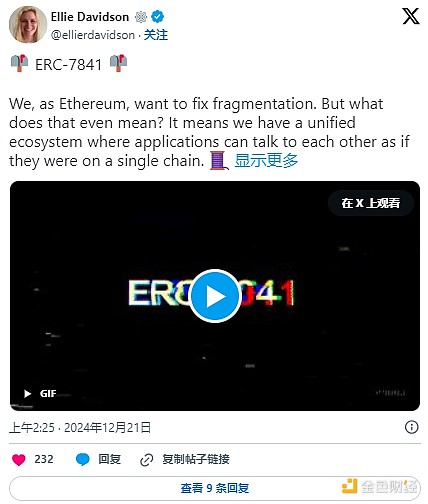
Author: Kazu Umemoto, Bankless; Compiler: Deng Tong, Golden Finance
Ethereum is a vibrant network, and a world-class developer network helps it stay ahead of the curve.
In 2024, Ethereum made significant progress in its rollup-centric evolution, with the introduction of the blob space through the Dencun upgrade, helping L2 reduce transaction costs by 10 to 100 times.
Today, we take a look at some of my Ethereum Improvement Proposals (EIPs) and Ethereum Exposure Drafts (ERCs) to watch this year. Some of these are already planned for the Pectra upgrade, which we cover in full here , while others may be further away but already have some high-profile backers.
Below, let’s take a look at five noteworthy Ethereum upgrades advocated by builders.
EIP-3074The other most talked about improvement included in the Pectra upgrade is EIP-3074. This upgrade provides a simpler, cheaper, and better user experience for anyone interacting with Ethereum. Users will be able to bundle multiple transactions into 1, projects can sponsor users' transactions and pay their gas fees, and there is now a way to recover your wallet if you lose your private key.
EIP-7251Validators with large amounts of ETH will love EIP-7251 as they will now be able to receive additional rewards for any ETH staked amount above the 32 ETH standard. Previously, any ETH staked amount above 32 ETH was just sitting there idle. If a validator wants to stake, they must set up a completely different validator node and have an additional 32 ETH. With 7251, they were able to set up a validator node and stake all the ETH they held. Hopefully this will lead to large institutions running their own validator nodes and participating more in the ecosystem.
The addition of Pectra can also increase the speed of the Ethereum network through validator integration. Projects like Lido can now run fewer validator nodes because they can earn rewards on any ETH staked amount above the 32 ETH base amount.
EIP-7002Pectra includes: Let’s say you want the rewards of running a validator node, but don’t want to deal with the useless stuff. You can delegate this responsibility to validator node operators and provide them with the validator key, which is used to certify and propose blocks. At some point later, you want to withdraw your ETH and do other things with it, but the only way you can withdraw your ETH is to sign a "voluntary exit message" with your validator key. If an operator decides to trick you into not signing a message or the validator key is compromised, someone could hold your ETH for ransom.ransom.
With EIP-7002, stakers can withdraw their ETH simply using the withdrawal key. This eliminates the risk of a malicious operator not signing the exit message or the validator key being compromised and your ETH being held for ransom.
ERC-7683Intentions have been a hot topic in DeFi over the past few years, and ERC-7683 is a token standard that attempts to address interoperability issues head-on and define a shared structure for cross-chain intentions. , “like an order ticket that anyone can create and any solver can implement,” reads the ERC website.
The standard was first released in 2024 and was written by Uniswap and Across Protocol. As ERC-7683 continues to be adopted, we can see tremendous progress being made in the interoperability space.
ERC-7841ERC-7841 is a very young token standard that attracted some attention over the holidays for its approach to addressing interoperability. The standard proposes a low-level message format and API for applications to read and write messages from other chains. 7841 eliminates any kind of chain-specific logic so that applications can launch across multiple chains seamlessly. There are other EIPs with similar goals, but the continued excitement here shows the strong momentum for interoperability.










